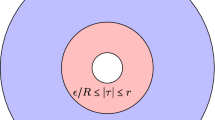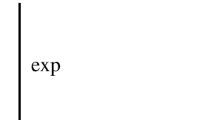Abstract
The main motivation for the paper is to understand which hyperelliptic curves of genus 3 defined over a field K of characteristic \(\ne \)2 appear as the image of the Donagi–Livné–Smith construction. By results in Frey and Kani (Lecture Notes in Computer Science, vol. 7053, pp. 1–19. Springer, Heidelberg, 2012) this means that one has to determine the intersection W of a Hurwitz space defined by curves of genus 3 together with cover maps of degree 4 to \(\mathbb {P}^1_K\) and a certain ramification type with the hyperelliptic locus in the moduli space of curves of genus 3. To achieve this aim we first study hyperelliptic curves of genus g as smooth curves C in \(\mathbb {P}^1_K\times \mathbb {P}^1_K\) and prove that, under mild conditions on K, the curve C can be given by a “\((g+1,2)\)-normal form”, namely by an affine equation in two variables of partial degrees \(g+1\) and 2 and hence of total degree \(\le \)g + 3, which is smaller than the degree of Weierstraß normal forms. Such curves are naturally parameterized by a Hurwitz space \(\overline{\mathcal{H}}_{g,g+1}\). We then specialize to \(g=3\) and introduce Hurwitz spaces for 4-covers with special ramification types. The study of these spaces enables us to determine that W is irreducible of dimension 4. Moreover we find an explicitly given K-rational family of curves C in (4, 2)-normal form such that the isomorphism classes of its members are in W(K) and such that the image of the family in W is Zariski-dense. For these curves we describe the “inverse” of the Donagi–Livné–Smith construction.
Similar content being viewed by others
Notes
We want to remark here that the arguments given in [5, Sect. 5.2], for this claim are not sufficient. So part of the motivation for this paper is to repair this gap.
By a linear change of variables that positions a K-rational point at \((\infty ,\infty )\in \mathbb {P}^1_K\times \mathbb {P}^1_K\), one can even achieve degree \(g+2\), which is optimal [2]. Recall that the Weierstraß normal forms have degree \(\ge \)2g + 1.
As an analogy, the reader might like to look at the Legendre family of elliptic curves E consisting of elliptic curves whose points of order 2 are K-rational.
Personal communication (E-mail to the authors), 28 June 2014.
We want to thank the anonymous referee for the key idea of this proof which considerably shortens our original argument.
We are very thankful to Marc Hindry and Christophe Ritzenthaler for answering our question concerning the dimension of the above family very quickly.
References
Cohen H., Frey G. (eds.): Handbook of Elliptic and Hyperelliptic Curve Cryptography. CRC Press, Boca Raton (2005).
Coppens M., Martens G.: Linear series on 4-gonal curves. Math. Nachr. 213, 35–55 (2000).
Diem C.: On the discrete logarithm problem for plane curves. J. Théor. Nr. Bordx. 24, 639–667 (2012).
Diem C., Gaudry P., Thom E., Thériault N.: A double large prime variation for small genus hyperelliptic index calculus. Math. Comput. 76, 475–492 (2007).
Frey G., Kani E.: Correspondences on hyperelliptic curves and applications to the discrete logarithm. In: Security and Intelligent Information Systems, International Joint Conference, Warsaw, 2011. Lecture Notes in Computer Science, vol. 7053, pp. 1–19. Springer, Heidelberg (2012).
Ghorpade S.R., Lachaud G.: Etale cohomology, Lefschetz theorems and number of points on singular varieties over finite fields. Mosc. Math. J. 2, 589–631 (2002).
Gutierrez J., Shaska T.: Hyperelliptic curves with extra involutions. LMS J. Comput. Math. 8, 102–115 (2005).
Hartshorne R.: Algebraic Geometry. Springer, New York (1977).
Hungerford T.: Algebra. Springer, New York (1974).
Kani E.: Castelnuovo’s equivalence defect. J. Reine Angew. Math. 352, 24–70 (1984).
Kani E.: Hurwitz spaces for hyperelliptic curves of genus 3. Preprint (2014).
Lercier R., Ritzenthaler C.: Hyperelliptic curves and their invariants: geometric, arithmetic and algorithmic aspects. J. Algebra 372, 595–636 (2012).
Mumford D.: Geometric Invariant Theory. Springer, Berlin (1966).
Smith B.: Isogenies and the discrete logarithm problem in Jacobians of genus 2 hyperelliptic curves. In: EUROCRYPT 2008. Lecture Notes in Computer Science, vol. 4965, pp. 163–180. Springer, Heidelberg (2008). Revised version in: J. Cryptol. 22, 505–529 (2009).
Stichtenoth H.: Algebraic Function Fields and Codes, 2nd edn. Springer, Berlin (2008).
Acknowledgments
We would like to thank the referees for their extremely careful reading of the paper, for their numerous useful comments which greatly improved the exposition of this paper, and for providing a long list of typos, some of which required considerable ingenuity and insight to find. The second author gratefully acknowledges funding of this research by a Discovery Grant from the Natural Sciences and Engineering Research Council of Canada (NSERC).
Author information
Authors and Affiliations
Corresponding author
Additional information
Dedicated to the Memory of Scott A. Vanstone.
This is one of several papers published in Designs, Codes and Cryptography comprising the “Special Issue on Cryptography, Codes, Designs and Finite Fields: In Memory of Scott A. Vanstone”.
Rights and permissions
About this article
Cite this article
Frey, G., Kani, E. Normal forms of hyperelliptic curves of genus 3. Des. Codes Cryptogr. 77, 677–712 (2015). https://doi.org/10.1007/s10623-015-0122-2
Received:
Revised:
Accepted:
Published:
Issue Date:
DOI: https://doi.org/10.1007/s10623-015-0122-2




